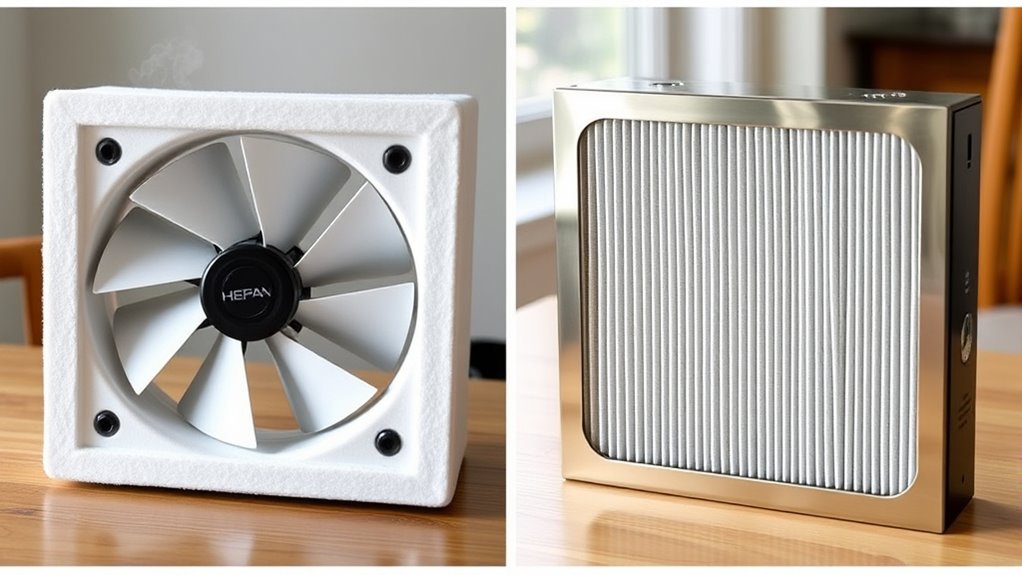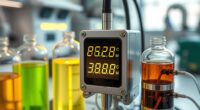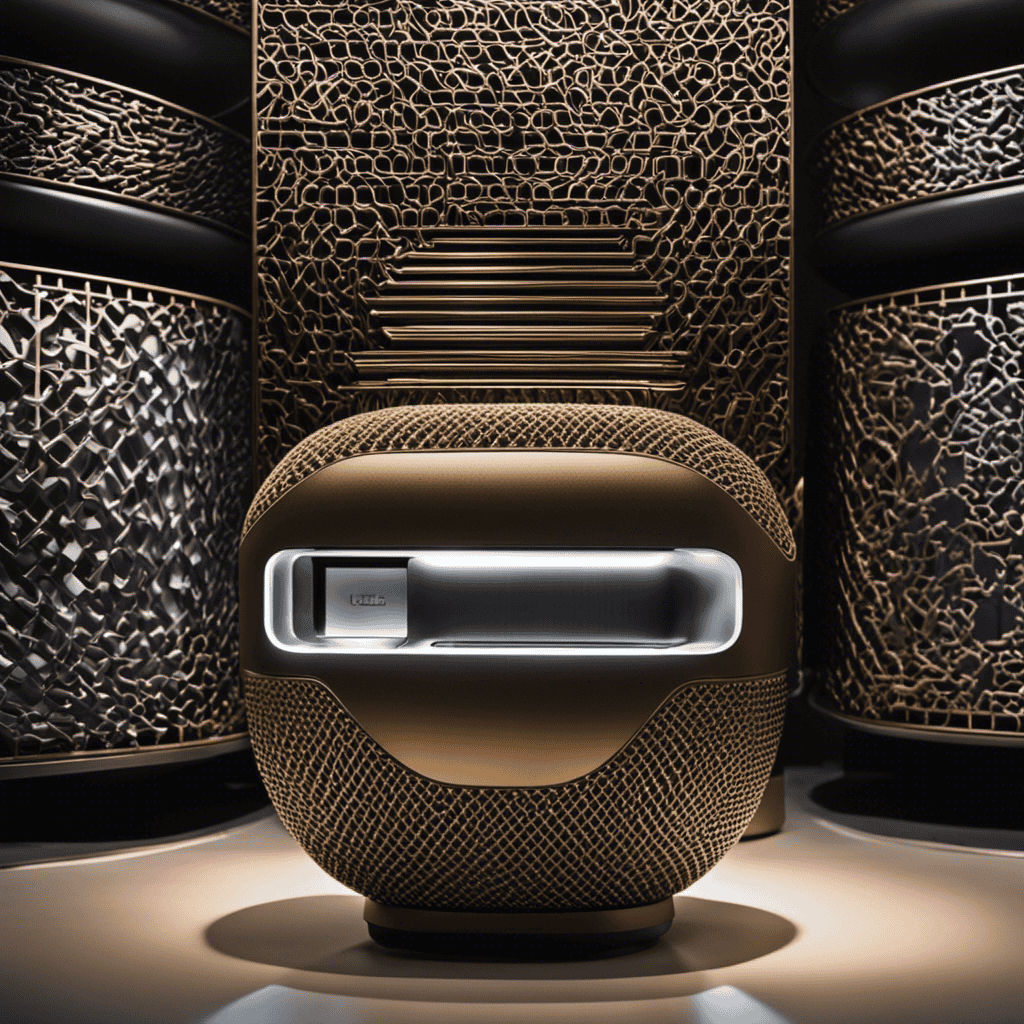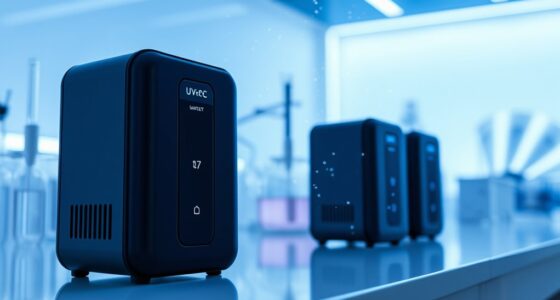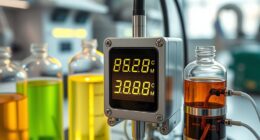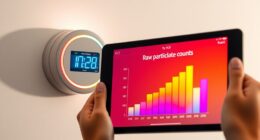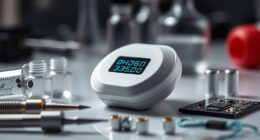DIY box fan filters are a budget-friendly choice, costing around $30–$80, but they don’t match the filtration efficiency of brand-name HEPA purifiers, which typically remove 99.97% of 0.3-micron particles. While DIY setups are easy to assemble and customizable, they often fall short in filtering fine particles and pathogens. If you’re curious about how they compare in performance, costs, and maintenance, there’s more to uncover below.
Key Takeaways
- HEPA filters trap ≥99.97% of 0.3-micron particles, outperforming most DIY filters in pathogen removal.
- DIY box fan filters cost $30–$80, while brand-name HEPA units typically range from $150–$500.
- DIY setups are easy to assemble and customize but require manual filter changes; HEPA units are pre-assembled with longer-lasting filters.
- HEPA filters provide consistent, high-efficiency air cleaning; DIY filters have variable performance depending on filter quality.
- Maintenance costs are generally lower and more straightforward with HEPA purifiers due to built-in indicators and durable filters.
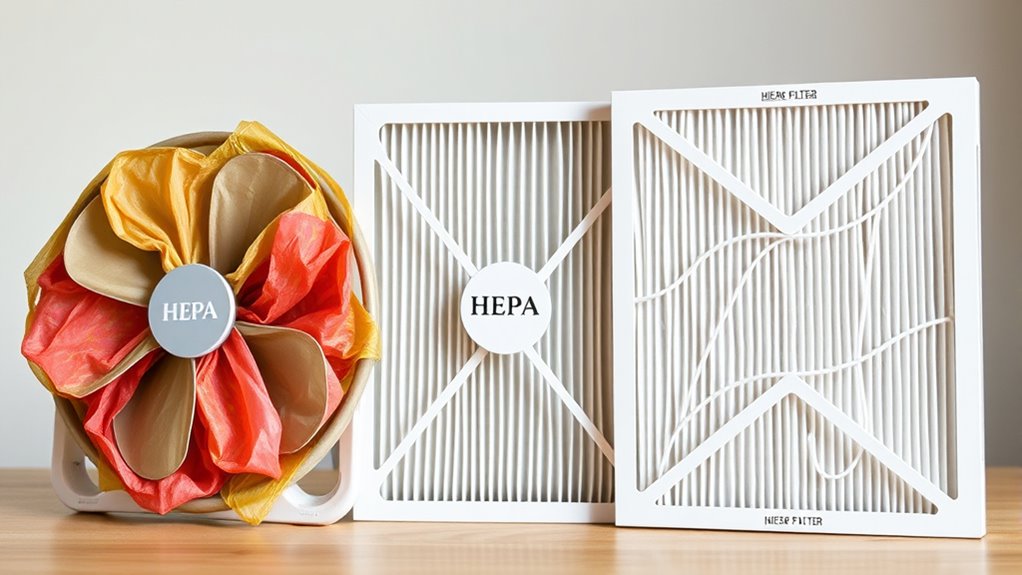
When it comes to improving indoor air quality, many people wonder whether DIY box fan filters can match the effectiveness of brand-name HEPA filters. The answer depends on several factors, including air purifier efficiency and cost comparison. DIY filters, typically made with household box fans and common HVAC filters, are a popular budget-friendly option. They’re easy to assemble and can be customized to fit your space. However, their overall performance varies, and understanding how they stack up against brand-name HEPA units is essential.
Air purifier efficiency is a key consideration. HEPA filters are engineered to trap at least 99.97% of airborne particles as small as 0.3 microns. This high level of filtration makes them highly effective against allergens, dust, pet dander, and some bacteria. In contrast, DIY box fan filters often use general furnace filters, which may have a lower MERV rating. While some high-quality filters can approach HEPA efficiency, most DIY setups don’t achieve the same level of particle removal. This doesn’t mean DIY options are useless, but they might not provide the same all-encompassing filtration, especially for fine particles and airborne pathogens.
HEPA filters trap 99.97% of particles at 0.3 microns, outperforming most DIY filter setups.
Cost comparison is another vital aspect. DIY box fan filters are considerably cheaper upfront. You can buy a decent box fan for around $20 to $50, and a high-MERV furnace filter might cost another $10 to $30. The total initial investment often stays under $100. Brand-name HEPA air purifiers, on the other hand, typically cost between $150 and $500, depending on features and coverage area. While the upfront cost is higher, these units often come with warranties, advanced features, and consistent performance, which might justify the expense for some users.
Maintenance also impacts the overall cost. DIY filters require regular replacement of filters, which can be inexpensive but might involve frequent changes if you want to maintain good air quality. HEPA purifiers usually have indicator lights for filter replacement and are designed for longer-lasting filters, making maintenance more straightforward.
Frequently Asked Questions
How Long Do DIY Filters Typically Last Before Needing Replacement?
Typically, DIY filters last about 3 to 6 months before needing replacement. You should monitor the filter’s condition regularly, as the filter lifespan varies based on usage, air quality, and filter material. To maintain ideal filtration, replace your DIY filter when it becomes visibly dirty or clogged. Regular replacement ensures effective air cleaning and helps you avoid decreased airflow or reduced filter efficiency over time.
Are DIY Box Fan Filters Effective Against All Airborne Pathogens?
You might wonder if DIY box fan filters can effectively block all airborne pathogens. While they do improve air quality and filter out many particles, their effectiveness varies depending on filter quality and setup. Generally, DIY filters are less reliable against smaller airborne pathogens compared to commercial HEPA filters. So, while they help reduce some risks, they may not provide complete protection against all airborne pathogens.
What Safety Precautions Should I Take When Assembling DIY Filters?
Think of assembling your DIY filter like building a sturdy bridge—you need safety first. Always prioritize electrical safety by unplugging the fan before working on it. Wear gloves and a mask to protect against material hazards from filters or adhesives. Use scissors carefully and make certain all parts are secure and away from children or pets. These precautions keep you safe while creating an effective air purifier.
Can DIY Filters Be Used in Commercial or Industrial Settings?
You can use DIY filters in some industrial applications, but they typically don’t meet strict commercial standards. For high-risk environments, certified HEPA filters are recommended to guarantee safety and efficiency. DIY options might work for small-scale or less critical tasks, but always check industry guidelines first. In commercial or industrial settings, prioritize professional-grade filtration to comply with safety regulations and maintain air quality.
How Do Noise Levels Compare Between DIY Filters and Branded HEPA Units?
You might wonder about the noise comparison between DIY filters and branded HEPA units. Generally, DIY setups tend to have lower sound levels since they use smaller fans or slower speeds to reduce noise. Branded HEPA units often have more powerful fans, which can generate louder sound levels, especially at higher settings. If quiet operation matters, DIY filters can be a good choice, but expect some increase in noise with more powerful, commercial-grade units.
Conclusion
Now, picture yourself in a room filled with fresh, crisp air swirling past a DIY box fan filter or a sleek brand-name HEPA. Both can clear the dust and allergens, but the DIY option offers a tangible, hands-on feeling—you get to build it, tweak it, and watch your creation work. Whether you choose the convenience of a store-bought HEPA or the satisfying craft of a DIY filter, your space will soon feel brighter, cleaner, and more inviting.
